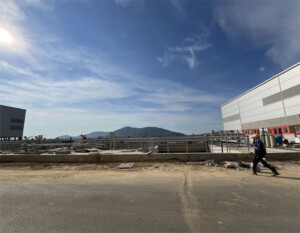光伏廢水處理中的芬頓氧化法是一項高效而重要的技術,主要用於處理光伏行業在矽棒的切割、研磨、切片以及矽片的研磨、腐蝕和拋光過程中產生的輔助廢液和清潔廢水。這些廢水中含有高濃度的有機物(如聚乙二醇)、懸浮物(如矽粉、碳化矽)和氟離子、酸和鹼等污染物,難以處理。以下是光伏廢水處理中芬頓氧化法的詳細分析:
1. 芬頓氧化法的原理
芬頓氧化法是一種先進的氧化技術,基於芬頓試劑(由過氧化氫和亞鐵離子組成)在酸性條件下的化學反應。在此過程中,亞鐵離子 (Fe^2+) 與過氧化氫 (H2O2) 反應作為催化劑生成羥基自由基 (·OH) 具有高氧化能力。這些羥基自由基具有極強的氧化勢,可以非選擇性地氧化和降解水中的大部分有機物,並最終將它們礦化成二氧化碳、水和無機鹽等小分子。

2. 芬頓氧化法在光伏廢水處理中的應用
1. 治療效果:
芬頓氧化法可以有效地分解廢水中的有機污染物,甚至可以將其完全氧化分解成無害的物質,而不會造成新的污染。
對於光伏廢水中高濃度的有機物和懸浮物,芬頓氧化法顯示出較強的處理能力,顯著提高了廢水的生物降解性,為後續生物處理提供了有利條件。
2. 影響因素:
pH值:Fenton 反應的最佳 pH 值通常在 2 到 4 之間。在此範圍內,Fe^2+ 主要以遊離形式存在,有利於羥基自由基的生成。pH 值過高或過低都會抑制羥基自由基的產生,降低治療效果。
反應時間:反應時間對治療效果有重大影響。在反應初期,COD 去除率迅速增加;隨著反應時間的延長,去除率的增長逐漸減慢。因此,需要通過實驗來確定最佳反應時間,以平衡治療效果和成本。
H2O2 和 Fe^2+ 的用量: H2O2 和 Fe^2+ 的用量是影響處理效果的關鍵因素。適當增加用量可以提高處理效果,但過量使用會導致雙氧水分解產生氧而不是羥基自由基,降低處理效率,增加成本。
3. 實際應用中的注意事項:
在實際應用中,需要根據光伏廢水的具體成分和性質進行實驗,以確定最佳的芬頓氧化條件。
芬頓氧化法處理的廢水可能含有一定量的鐵離子和懸浮物,需要通過後續的處理過程(如混凝、沉澱、過濾等)去除。
考慮到芬頓氧化法的成本問題(如過氧化氫和硫酸亞鐵的成本、污泥處理成本等),在實際應用中可能需要將其與其他處理方法相結合,以提高整體處理效率和經濟性。
3. 總結
芬頓氧化法作為一種高效、環保的廢水處理技術,在光伏廢水處理中具有廣闊的應用前景。通過優化反應條件和處理工藝組合,可以進一步提高處理效果和經濟性,為光伏行業的可持續發展提供有力支撐。